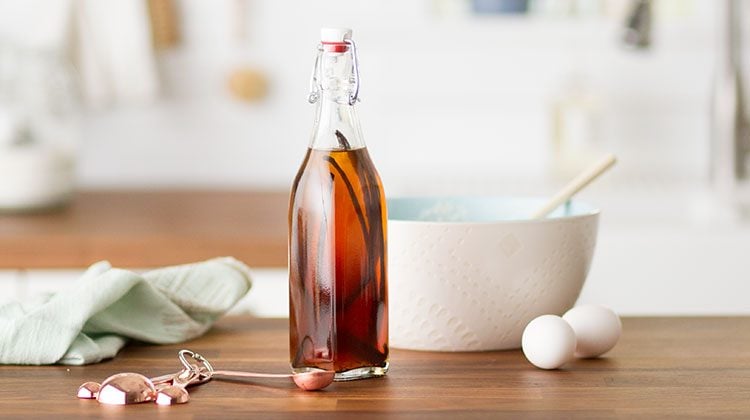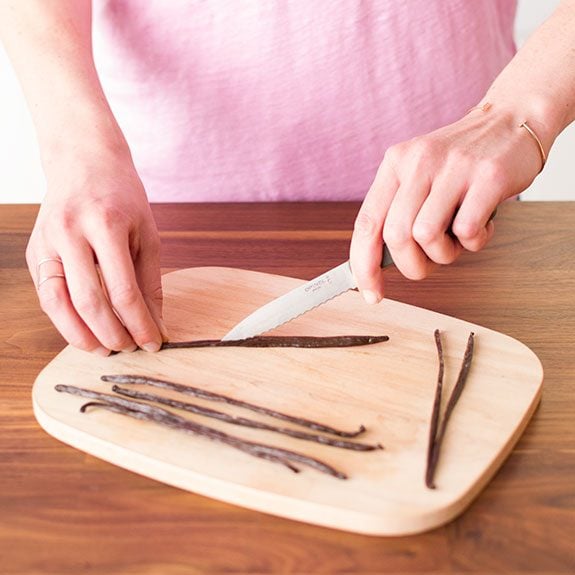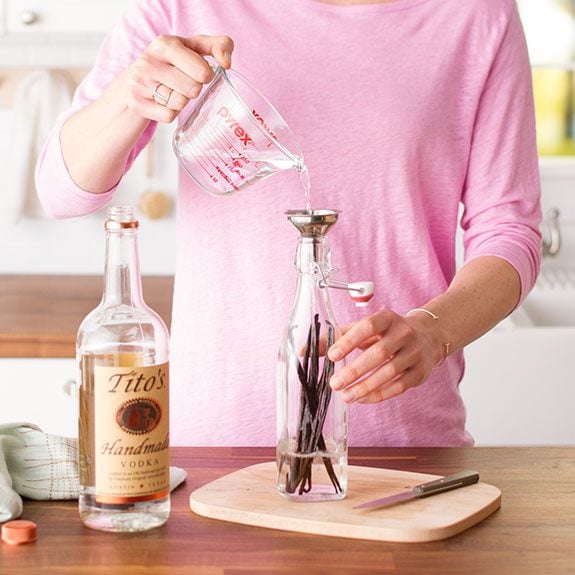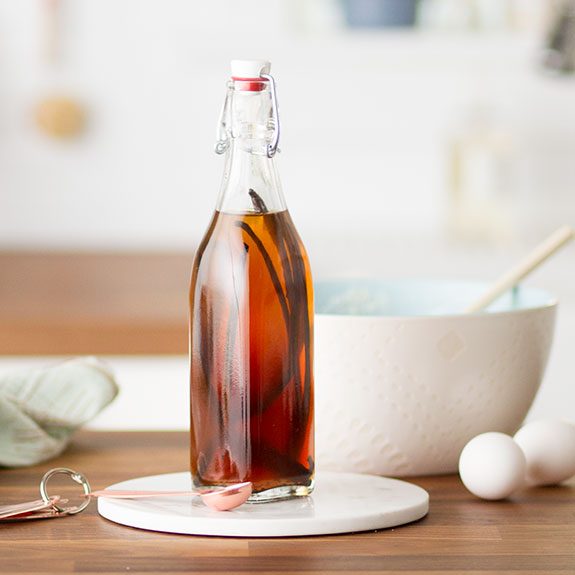How to Make Vanilla Extract
Updated: Jul. 12, 2022
Whether you want a custom flavor (rum vanilla, anyone?) or want to avoid the additives in store-bought extract, we've got a foolproof formula for making vanilla extract at home.

With hundreds of flavors of ice cream available, from mint chip to rocky road, surveys show that year after year, vanilla remains the popular favorite. It’s one of the most loved flavors in the world-quite a feat for an ingredient as difficult to grow and harvest as vanilla.
The vanilla bean is a stalk of flowering orchids. The plants take two to three years to flower, and must be pollinated by hand for the beloved beans to develop. Once ready, the beans air-dry for a full month. The labor-intensive process is part of the reason vanilla can be quite pricey, but its myriad uses make it worth it. From adding signature flavoring to chocolate chip cookies and classic frosting, to creating surprising cameos in glazed veggies and even turkey, we find ourselves reaching for vanilla all the time.
While we enjoy store-bought vanillas, making homemade vanilla extract is a great way to control the flavor of the extract-plus it’s a great excuse to buy vanilla beans, which contribute flavor to the extract and then can be re-used for other purposes (we’ve got a whole list below). (Here are 45 other foods you’re buying that you should consider making instead.)
Choosing the Right Ingredients for Vanilla Extract
Homemade extract uses only two ingredients: vanilla beans and alcohol. Your choice of what kind of each to use will impact the flavor, so let’s take a quick look at your choices.
What’s the difference between vanilla bean varieties?
There are several varieties of vanilla beans, each with its own flavor profile. (They may have different price points as well, depending on availability.) Here are our favorites:
- Madagascar or Bourbon: traditional, full bodied, strongest flavored of all the beans
- Mexican: smoothly flavored with a bit of spice
- Tahitian: delicately flavored, fruity and floral
What kind of alcohol works best?
Most recipes call for vodka because it lends a fairly neutral flavor. If you want to add another flavor note to the extract, you can use a stronger flavored liquor. Warm, darker drinks like bourbon and brandy taste especially good in holiday baking recipes. Rum would add a tropical flavor that would be delicious with fruits and other sweets.
Test Kitchen Tip: Wondering why we use alcohol? Alcohol aids in food preservation, preventing spoilage. Don’t worry about the alcohol content: Most of the alcohol cooks out during baking.
Tweaking the different types of beans and booze can be fun. Bottles of homemade vanilla extract make a great food gift.
Here’s how to make vanilla extract at home:
You’ll need:
6 vanilla beans, any type
2 cups of vodka (pictured below), or other alcohol of your choice
A tall jar with a seal, freshly cleaned and dried

Step 1: Split the Beans
Using a sharp knife, slice down the middle of the vanilla bean. This will open up the harder exterior, revealing an interior packed with moist, tiny seeds. (This is one of my favorite smells in the world!) You don’t have to scrape out the seeds; you’re just exposing them so they can contribute flavor to the extract.

Step 2: Set Up Your Jar
Place the beans, including the seeds, in a tall jar. Pour in the vodka until the beans are covered by at least 1/2-inch. Some of the beans may float. That’s OK; they’ll settle down eventually.
Seal the jar tightly.

Step 3: Allow to Steep
The rest of the work is done by time. The beans will slowly release flavor into the liquid until it’s concentrated and rich. This takes at least six weeks. The alcohol will darken over time; the vodka will turn brown.
Once a week or so, gently shake the jar.
Step 4: Strain Out the Beans and Store
After six weeks, open up the jar. The extract is ready if it’s deeply fragrant. (You can taste-test a bit, too.) Remove the beans and re-cap the extract. You can use it just as you would store-bought extract. Bear in mind that if your extract is more mild, you may want to adjust a recipe to use a bit more.
How Long Will Homemade Vanilla Extract Last?
Stored in a cool, dry place, away from direct sunlight, your homemade vanilla extract can keep for several years. The flavor will be best for the first year, though; it will fade over time.
How to Use Your Vanilla Beans after Making Extract
Don’t throw away your vanilla beans! Even after they’ve steeped, they still have plenty of flavor. Here are our favorite uses for them.
Make vanilla sugar.
Let the beans dry completely, then drop them in a big jar or canister and pour in sugar. (Use about 2 cups granulated sugar per vanilla bean.) Store in an airtight container for two weeks. When you open it up, all of the sugar will have taken on a fragrant vanilla flavor. Use it in place of regular, granulated sugar any time you want an extra jolt of vanilla. I love it in my morning coffee.
Season salt.
Follow the same process as above, with a small dish of salt instead of sugar. This yields an aromatic salt that works well as a finisher to roast meats like pork or turkey, or as a sprinkle over rice, a salad or sliced tomatoes.
Flavor coffee.
Stir your coffee with a vanilla bean instead of a stir stick, or simmer milk with a vanilla bean before adding to coffee. Coffee tastes amazing with a bit of spice.
Flavor poached fruit or compotes.
Toss the vanilla bean into a pot of poaching fruit, or stir into a compote or fridge jam to add flavor.